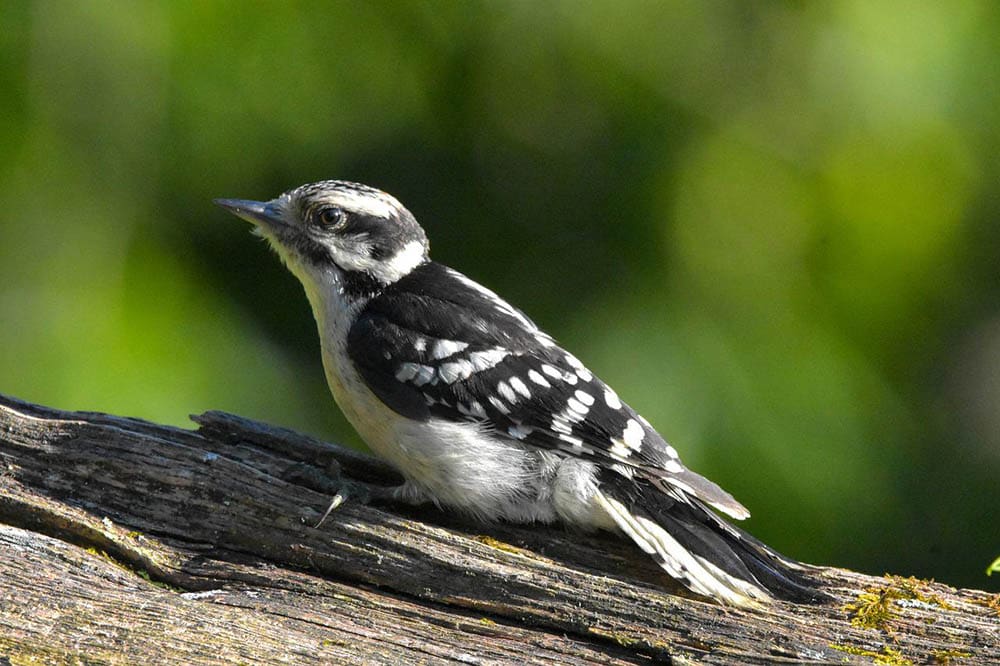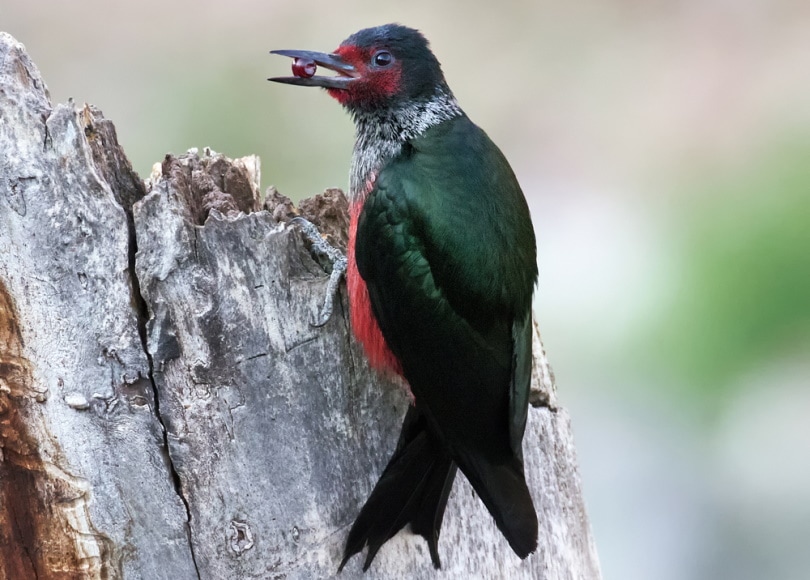12 Species of Woodpeckers in Arizona (with Pictures)
Last Updated on

There is a wide array of environments in Arizona, which means there are multiple woodpecker species in the state. Some woodpeckers live in mature forests and others live in the desert, and each has their own unique way of surviving in the different environments.
To give you a better idea of what you can hope to find in the Copper State, we highlighted all 12 woodpecker species that live in Arizona.

The 12 Species of Woodpeckers in Arizona
1. Acorn Woodpecker

| Population | 7.5 million |
| Wingspan | 14 to 17 inches |
| Weight | 2.3 to 3.2 ounces |
| Length | 7.5 to 9 inches |
Unlike many woodpeckers that are solitary birds, the acorn woodpecker is cooperative in almost every way. As a group, they gather hundreds of acorns and stuff them into holes that they drill with their beaks. Common targets of their drilling are various trees and telephone poles, making them a pest in certain regions.
2. Downy Woodpecker

| Population | 14 million |
| Wingspan | 10 to 12 inches |
| Weight | 0.75 to 1 ounce |
| Length | 5.7 to 6.7 inches |
Downy woodpeckers are among the smallest woodpeckers that you can find in Arizona, and the state is as far south as you’ll find these small birds.
If you put out a bird feeder, the most likely woodpecker to visit is a downy woodpecker, and that’s because their small beaks can reach areas that large woodpeckers simply can’t. While the downy woodpecker is often in a flock, they don’t always hang out with birds of their own species!
3. Red-Naped Sapsucker

| Population | 2 million |
| Wingspan | 16 to 17 inches |
| Weight | 1.1 to 2.3 ounces |
| Length | 7.5 to 8.5 inches |
The red-naped sapsucker is a woodpecker species that loves to drill holes into trees. They drill row after row into aspen, birch, and willow trees, but surprisingly, this doesn’t cause long-term damage to the trees.
The holes that they drill also provide food sources for hummingbirds and other birds that need sap to survive. Since they only drill for the sap, you don’t have to worry about them going after telephone poles and other human-made wooden structures that can’t heal themselves.
4. Ladder-Backed Woodpecker

| Population | 2 million |
| Wingspan | 13 inches |
| Weight | 0.7 to 1.7 ounces |
| Length | 6.5 to 7.5 inches |
The ladder-backed woodpecker loves to eat insects and larvae, which is why they forage in branches and other areas where these tiny animals thrive. But if you’re trying to spot a ladder-backed woodpecker, it can be a bit of a challenge, as they stay hidden in heavy vegetation areas for most of their lives.
They don’t tend to fly for long periods either, instead opting to stay in one location and forage for food there.
5. Hairy Woodpecker

| Population | 9 million |
| Wingspan | 15 inches |
| Weight | 1.5 to 3.5 ounces |
| Length | 9 to 11 inches |
The hairy woodpecker is strikingly similar to the downy woodpecker, except for their size. Hairy woodpeckers are large and feed at the base of trees, among fallen logs, and even straight off the ground.
They don’t tend to fly high, but they prefer mature forests, so that’s where you’ll need to travel if you want to spot one.
6. Northern Flicker

| Population | 16 million |
| Wingspan | 16.5 to 20 inches |
| Weight | 4 to 5.5 ounces |
| Length | 11 to 12.2 inches |
While woodpecker isn’t in the name, the northern flicker is a woodpecker all the same. They’re migratory but have a year-long presence in Arizona.
If you’re trying to spot a northern flicker, head to open woods and keep your eyes toward the ground. Looking for their white body with black spots throughout is the easiest way to spot them.
7. Lewis’s Woodpecker

| Population | 69,000 |
| Wingspan | 19.5 to 20.5 inches |
| Weight | 3 to 5 ounces |
| Length | 10 to 11 inches |
Spotting Lewis’s woodpeckers is a challenge solely because of their dwindling numbers. They live in open woodlands and love dead trees where insects thrive on the bark.
Unlike many woodpeckers, the Lewis’s woodpecker rarely drills holes into trees. Instead, they eat insects right off the bark, as well as flying insects. These birds are named after Meriwether Lewis, who spotted the birds while traveling west in the well-documented Lewis and Clark expedition in 1805.
8. Williamson’s Sapsucker

| Population | 300,000 |
| Wingspan | 17 inches |
| Weight | 1.5 to 2 ounces |
| Length | 8.3 to 10 inches |
The Williamson’s sapsucker is a species of woodpecker that eats by drilling holes into trees and sipping the sap that comes out. However, they only drill shallow holes and don’t go after man-made wooden structures, so they don’t cause any damage.
If you’re trying to spot one, you’ll need to head to a mature forest and look for their preferred pine, larch, fir, Douglas fir, and aspen trees.
9. American Three-Toed Woodpecker

| Population | 1.1 million |
| Wingspan | 14.5 to 15.5 inches |
| Weight | 1.6 to 2.4 ounces |
| Length | 8.3 to 9 inches |
If you’re looking at trees and notice that a few of them have large portions of bark missing, there’s a good chance that there are American three-toed woodpeckers in the area. They rarely drill into trees, opting instead to strip off bark to look for insects.
They also tend to stay on one tree for an extended period, leading to trees with large portions of bark completely stripped off. They love areas with beetle outbreaks, and they’ll even venture into recently burned areas for easier foraging.
10. Gila Woodpecker

| Population | 1.5 million |
| Wingspan | 16 to 16.5 inches |
| Weight | 1.8 to 2.8 ounces |
| Length | 8.7 to 9.5 inches |
While many woodpeckers prefer traditional forests, if you want to spot a Gila woodpecker, you’ll need to head out to the desert regions in Arizona. They forage on cacti and other types of desert scrub, hunting for insects.
The Gila woodpecker is an extremely territorial bird, and they’ll circle their territory each day to drive out other woodpeckers and songbirds.
11. Gilded Flicker

| Population | 770,000 |
| Wingspan | 16.5 to 20 inches |
| Weight | 4 to 5.5 ounces |
| Length | 11 inches |
The gilded flicker is a woodpecker species that thrives in the Arizona desert. While they’re a woodpecker, they rarely forage into trees or cacti.
Instead, the gilded flicker forages extensively on the ground, looking for ants and anthills to eat from. They will perch on cacti, though, so if you’re trying to spot one or two in the wild, that is where you should look.
12. Arizona Woodpecker

| Population | 200,000 |
| Wingspan | 14.2 inches |
| Weight | 1.2 to 1.8 ounces |
| Length | 7 to 8 inches |
The Arizona woodpecker has the smallest range of any woodpecker on this list, and despite their name, you can only find them in a tiny area of the southernmost part of Arizona. While their population numbers are currently stable, their limited range puts them at a higher risk of population declines in the future.
They live in pine-oak, oak, and sycamore-walnut woodlands, but even there they only live at elevations between 4,000 and 8,000 feet.
Conclusion
Since there are so many diverse environments in Arizona, it’s one of the few states where you can spot birds that live in both forests and deserts. Woodpeckers can live in either environment, and now that you have a better idea of what’s out there, hopefully, you can identify the next woodpecker that you see!
You might be interested:
Featured Image Credit: JackBulmer, Pixabay
Table of Contents
About the Author Robert Sparks
Robert’s obsession with all things optical started early in life, when his optician father would bring home prototypes for Robert to play with. Nowadays, Robert is dedicated to helping others find the right optics for their needs. His hobbies include astronomy, astrophysics, and model building. Originally from Newark, NJ, he resides in Santa Fe, New Mexico, where the nighttime skies are filled with glittering stars.
Related Articles:
Monocular vs Telescope: Differences Explained (With Pictures)
10 Types of Hummingbirds in Arkansas (With Pictures)
8 Types of Hummingbirds in Nebraska (With Pictures)
5 Types of Hummingbirds in Idaho (With Pictures)
3 Types of Hummingbirds in Mississippi (With Pictures)
8 Types of Hummingbirds in Kansas (With Pictures)
5 Types of Hummingbirds in West Virginia (With Pictures)
5 Types of Hummingbirds in Ohio (With Pictures)
